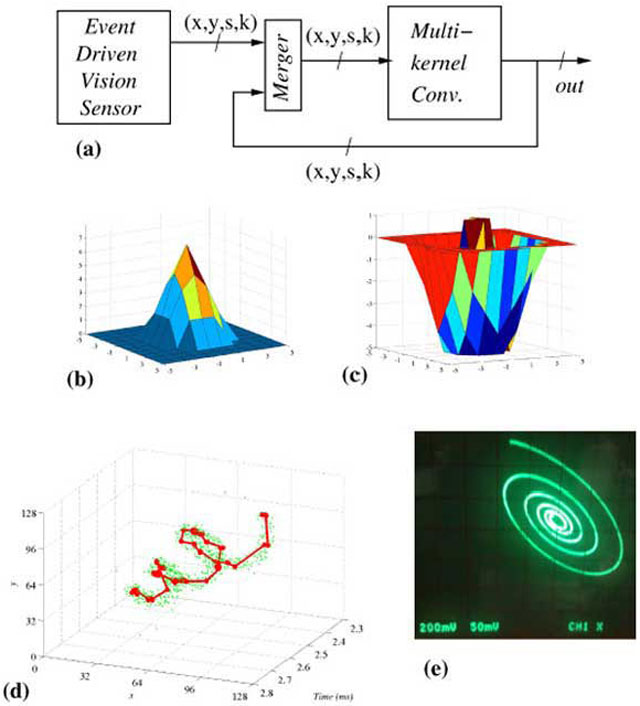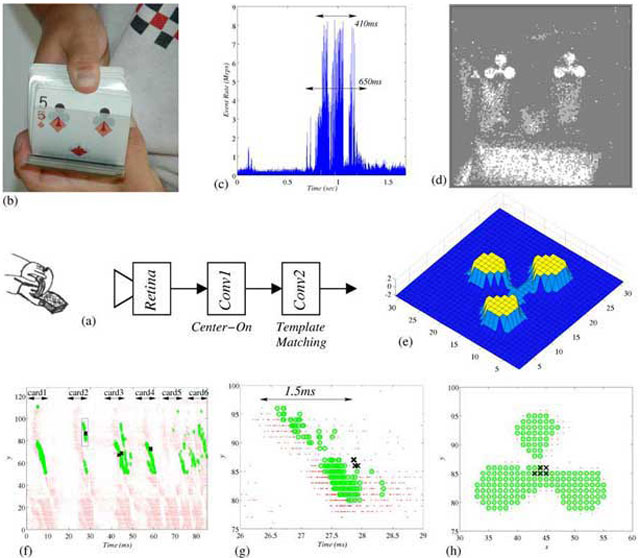

Brain-Inspired Neural Networks and Artificial Intelligence
The IMSE Neuromorphic group develops sensory and processing microchips that mimic sensing and processing in biological beings. It also develops multi-chip and hybrid chip-FPGA systems to scale up to higher complexity systems. The group also works on algorithms and sensory processing for spiking information sensing, coding and processing. Chips use mixed signal, low current, and/or low power, circuit techniques, as well as high speed communication techniques. The group uses mixed or digital CMOS technologies, as well as application projections exploiting emergent nanoscale technologies or new devices like memristors.
At present, the group focuses mainly on event-driven (spiking) frame-free vision systems, developing sensing retinas for spatial or temporal contrast (such as DVS -Dynamic Vision Sensors), as well as event-driven convolution processors, which allow to assemble for example large scale spiking 'Convolutional Neural Networks' for high speed object recognition. These chips and systems use AER (Address Event Representation) communication techniques.
Event-driven retinas do not produce sequences of still frames, as conventional video cameras do. Instead, each pixel senses light and computes a given property (spatial contrast, temporal change) continuously in time. Whenever this property exceeds a given threshold, the pixel sends out an event (which usually consists of the pixel x,y coordinate and the sign of the threshold), which is written onto one (or more) high speed bus with asynchronous handshaking. This way, sensors produce continuous event flows, and subsequent processors process them event by event.


Bernabé Linares Barranco< >
Google Scholar
Teresa Serrano Gotarredona< >
Google Scholar
Luis A. Camuñas Mesa< >
Google Scholar
A. Yousefzadeh, M. Khoei, S. Hosseini, P. Holanda, S. Leroux, O. Moreira, J. Thapson, B. Dhoet, P. Simoens, T. Serrano-Gotarredona, and B. Linares-Barranco, "Asynchronous Spiking Neurons, the natural key to exploit temporal sparsity", IEEE Journal on Emergent and Selected Topics in Circuits and Systems, vol. 9, no. 4, pp. 668-678, 2019 » doi
A. Yousefzadeh, E. Stromatias, M. Soto, T. Serrano-Gotarredona and B. Linares-Barranco, "On Practical Issues for Stochastic STDP Hardware with 1-bit Synaptic Weights", Frontiers in Neuroscience, vol. 12, article 665, 2018 » doi
A. Yousefzadeh, M. Jablonski, T. Iakymchuk, A. Linares-Barranco, A. Rosado, L.A. Plana, S. Temple, T. Serrano-Gotarredona, S. Furber, and B. Linares-Barranco, "On Multiple AER Handshaking channels over High-Speed Bit-Serial Bi-Directional LVDS Links with Flow-Control and Clock-Correction on Commercial FPGAs for Scalable Neurmorphic Systems", IEEE Trans. on Biomedical Circuits and Systems, vol 11, no. 5, pp. 1133-1147, 2017 » doi
[B] J. A. Pérez-Carrasco, B. Zhao, C. Serrano, B. Acha, T. Serrano-Gotarredona, S. Chen and B. Linares-Barranco, "Mapping from Frame-Driven to Frame-Free Event-Driven Vision Systems by Low-Rate Rate-Coding and Coincidence Processing. Application to Feed-Forward ConvNets," IEEE Trans. on Pattern Analysis and Machine Intelligence, vol. 35, no. 11, pp. 2706-2719, 2013 » doi
[A] L. Camuñas-Mesa, C. Zamarreño-Ramos, A. Linares-Barranco, A. Acosta-Jiménez, T. Serrano-Gotarredona and B. Linares-Barranco, "An Event-Driven Multi-Kernel Convolution Processor Module for Event-Driven Vision Sensors," IEEE Journal of Solid-State Circuits, vol. 47, no. 2, pp. 504-517, 2012 » doi
SPINAGE: Weighted Spintronic-Nano-Oscillator-based Neuromorphic Computing System Assisted by laser for Cognitive Computing
PI: Teresa Serrano-Gotarredona
Funding Body: European Union
Oct 2020 - Sep 2024
NeurONN: Two-Dimensional Oscillatory Neural Networks for Energy Efficient Neuromorphic Computing
» Press Release
PI: Bernabé Linares-Barranco
Funding Body: European Union
Jan 2020 - Dec 2022
HBP: Human Brain Project
PI: Bernabé Linares-Barranco
Funding Body: European Union
Apr 2014 - Mar 2016
SITIO WEB
NABAB: Nanocomputing Building Blocks with Acquired Behaviour
PI: Teresa Serrano Gotarredona
Funding Body: European Union
Apr 2007 - Apr 2010
SITIO WEB
CAVIAR: Convolution AER Vision Architecture
PI: Bernabé Linares-Barranco
Funding Body: European Union
Jun 2002 - Jun 2006
SITIO WEB